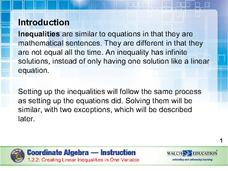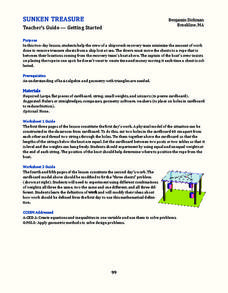Curated OER
Not All Classrooms Are Created Equal
Insights as to why a certain instructional techniques may work, or not work, for every school or every classroom.
Curated OER
Bringing the World of Educational Apps Into Your Classroom
There are many things to consider before introducing new technology to your learners.
University of Georgia
Density and Texture of Soil
All soil is not created equal! A lab activity asks learners to collect and analyze soil. Specific calculations determine the amount of sand, silt, and clay in a sample and allow individuals to identify the soil texture.
BW Walch
Creating Linear Inequalities in One Variable
Just when a young mathematician starts to feel comfortable turning word problems into linear equations, shake things up and throw inequalities in the mix. This excellent, instructive presentation takes the steps for solving an...
CK-12 Foundation
Translation of Vectors and Slope: Rearranging a Classroom
Find out if vectors are equal in the classroom. Pupils use the interactive to create vectors showing the movements boys perform in rearranging classroom furniture. The scholars determine which boy moved furniture the farthest, or if they...
BW Walch
Creating Linear Equations in One Variable
The example of two travelers meeting somewhere along the road has been a stereotypical joke about algebra as long as algebra has existed. Here in this detailed presentation, this old trope gets a careful and approachable treatment....
Curated OER
Rules for Rubrics
How do you create an effective and fair rubric? Read this article to create the best rubric possible.
Curated OER
GSE Foundations of Algebra: Equations and Inequalities
Need lessons on writing and solving one- and two-step linear equations and inequalities, as well as systems of equations? This comprehensive 106-page module from the Georgia Department of Education contains many different lessons for a...
Curated OER
Bringing Animal Issues into the Classroom: César Chávez
Fifth graders get critical and political while they begin thinking about human and animal rights in relation to the US Constitution. This hand out includes answers to several questions regarding Cesar Chavez and his work to secure rights...
K12 Reader
Adjective or Adverb?
What's the difference between an adverb and an adjective? And aren't all -ly words adverbs? Reinforce the difference between adverbs and adjectives with a straightforward exercise.
Curated OER
Right to Equal Opportunity
Students investigate the concept of equal opportunity in school. In this equal opportunity lesson, students participate in a discussion about the fairness of certain situations in school. They listen to a story entitled, "Left Out",...
Curated OER
Infusing Equity by Gender Into the Classroom
High schoolers examine the gender equality of past civilizations. In this interdisciplinary lesson, students use history books to determine which of the ancient Greek City States was the most equitable concerning gender....
State Bar of Texas
Edgewood ISD v. Kirby
Have you ever wondered where the money comes from to pay for your school, teachers, supplies, and building? The 1989 Supreme Court case Edgewood ISD v. Kirby lays a framework for open discussion on the funding of public schools. Using a...
Union County Vocational Technical Schools
Engineering Drawing
Knowing the basics of drafting allows individuals to create drawings that show all the views and measurements necessary to allow others to visualize the original object. Pupils gain experience by drawing three orthographic views of...
Workforce Solutions
Egg-streme Sports
Challenge small groups to build a structure that catches a raw egg without breaking—working collaboratively and applying mathematical and engineering principles. Pretending the frame was made by a business, scholars create a marketing...
Scholastic
Martin Luther King, Jr.'s Dream - Mini Book
Celebrate the birthday of civil rights leader Martin Luther King, Jr. by sharing his dream of equality for all with young readers. This printable book includes simple sentences and one- and two-syllable words that make it a perfect...
Curated OER
Where are the Dinosaurs?
Learners find the similarities of dinosaurs and the animals of today. In this dinosaurs lesson, students understand why dinosaurs have become extinct. Learners research and create dinosaur dioramas and finger puppets.
Curated OER
The Gettysburg Address by Abraham Lincoln
"The Gettysburg Address" is the basis of a series of activities that not only model for learners how to conduct a close reading of a text, but also how a close reading can help them comprehend a difficult text. The detailed, step-by-step...
Curated OER
RIGHT TO EQUAL OPPORTUNITY
Students learn the importance of fairness and come up with strategies to create this type of environment in their classroom.
Curated OER
Sunken Treasure
You've located buried treasure, now what? Explore how to use algebraic and geometric methods to determine where to place a recovery ship based on the location of the treasure.
Shodor Education Foundation
Experimental Probability
Spin into a dicey experiment. Pupils use a spinner or a pair of dice to determine the experimental probabilities of each outcome. The interactive allows for either, one, five, or ten consecutive experiments. Using the applet, learners...
Curated OER
Math History Can Help Students Overcome Learning Difficulties
Negative numbers and mathematical notation are better understood by examining how they have been handled throughout history.
Curated OER
The Crayon Box that Talked: Welcoming Indviduality
Just like a box of crayons, every child has a special way of contributing to the greater picture.
Cornell University
Constructing and Visualizing Topographic Profiles
Militaries throughout history have used topography information to plan strategies, yet many pupils today don't understand it. Scholars use Legos and a contour gauge to understand how to construct and visualize topographic profiles. This...























